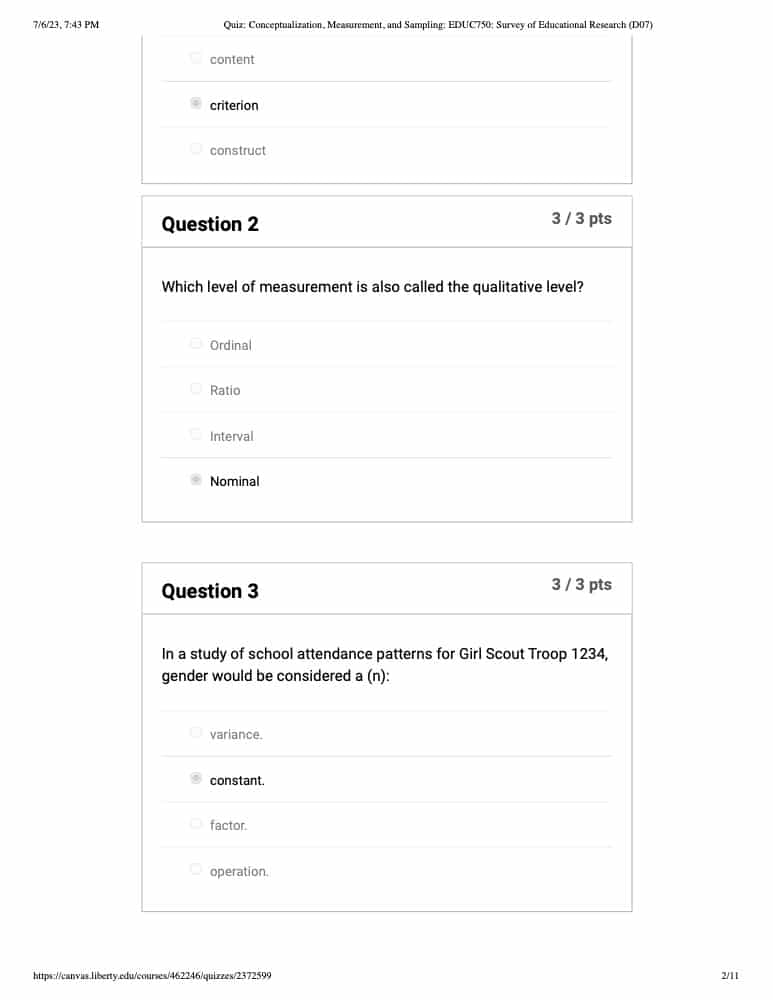EDUC 750 Quiz Conceptualization
EDUC 750 Quiz Conceptualization, Measurement, and Sampling
Covers the Learn material from Module 3: Week 3.
- Concurrent and predictive validity are types of _____ validity.
- Which level of measurement is also called the qualitative level?
- In a study of school attendance patterns for Girl Scout Troop 1234, gender would be considered a (n):
- Open ended questions are most often used in research involving:
- The important difference between the ratio level of measurement and the interval level is:
- At the nominal level of measurement, a variable’s attributes are exhaustive when:
- Kominski et al. (2001) found that _____ of U.S. children are considered “at risk.”
- Few resources, less qualied teachers, and lower academic performance are characteristics of:
- According to the authors, available online data are usually inaccurate.
- Researchers choose levels of measurement in the process of operationalizing variables.
- The ratio level of measurement identifies variables whose variables have no mathematical interpretation.
- Regardless of which standard of poverty is used, data show that the U.S. poverty level has increased since the 1990s.
- Completeness and saturation are two tests involved in _____ sampling.
- When evaluating sample quality, it is important to have a clear understanding about the:
- Which type of sampling ensures that the sample represents certain characteristics in proportion to the population?
- When may sampling be unnecessary?
- Which sampling technique is more desirable when the goal is generalizability?
- Which one of the following statements accurately describes a normal distribution?
- The statistic computed for the entire population is called the:
- The number of elements from one sample case to another is called the sampling:
- Sample generalizability refers to:
- Quota sampling does not use a random selection procedure.
- Choosing sites on the basis of their t with a typical situation helps increase the generalizability of the sample
- Generalizability will be unknown in qualitative research involving small, unrepresentative samples.
- Understanding sampling distributions is the foundation for understanding how statisticians can estimate sampling error.
Other sets
- At the nominal level of measurement, a variable’s attributes are exhaustive when:
- The absolute standard of poverty was developed by:
- Which type of validity is used when no clear criterion exists for validation purposes?
- Triangulation refers to the:
- Concurrent and predictive validity are types of _____ validity.
- Few resources, less qualied teachers, and lower academic performance are characteristics of:
- Kominski et al. (2001) found that _____ of U.S. children are considered “at risk.”
- The important difference between the ratio level of measurement and the interval level is:
- The ratio level of measurement identies variables whose variables have no mathematical interpretation.
- Level of measurement has important implications for the type of statistics that can be used in a study.
- Researchers choose levels of measurement in the process of operationalizing variables.
- Asking questions is the basis of surveys, and experimental and qualitative research.
- Systematic random sampling yields a simple random sample in all situations except:
- Completeness and saturation are two tests involved in _____ sampling.
- Which sampling method relies on a random selection procedure?
- Which one of the following statements accurately describes a normal distribution?
- Research in which information is obtained through the responses that all available members of an entire population give to questions is called a:
- How many steps are involved in systematic random sampling?
- The larger the sample, the more _____ the sampling distribution.
- Individual members of a sample whose characteristics are being measured are called:
- Snowball sampling would be most useful for studying which one of the following groups?
- Any single random sample can be thought of as just one of an innite number of random samples that, in theory, could have been selected from the population.
- Random selection is typically a haphazard process.
- Quota sampling does not use a random selection procedure.
- In order to evaluate the quality of a sample, the population must be clearly stated.
